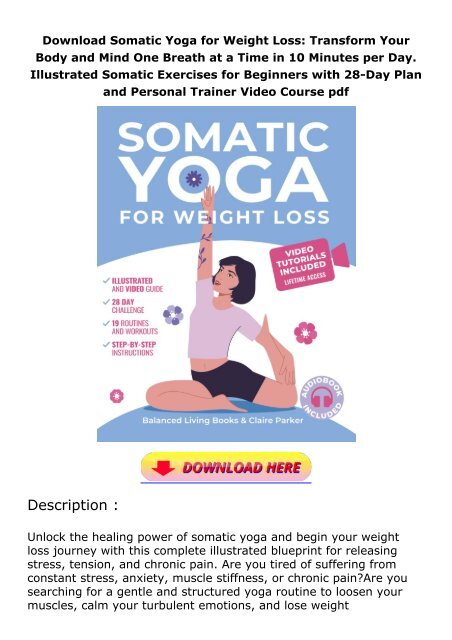
# **The Healing Potential of Somatic Yoga: Integrating Gentle Movements with Mindful Awareness**
In our rapidly changing world, numerous individuals seek yoga as a means to heal their bodies, soothe their minds, and uplift their spirits. However, traditional yoga may not be feasible for everyone, particularly those recovering from physical injuries, enduring chronic pain, or facing emotional challenges. This is where *somatic yoga* plays a vital role — a gentle and reflective practice that fuses mindful movement with somatic awareness, delivering profound and restorative experiences.
## **What Is Somatic Yoga?**
Somatic yoga merges the tenets of traditional yoga with *somatic movement therapy*, an attentive approach that prioritizes internal sensations over external forms. The term *”somatic”* is derived from the Greek word *soma*, which means “living body.” In contrast to traditional yoga that frequently stresses maintaining postures and structured sequences, somatic yoga introduces slow, flowing, and intuitive movements aimed at retraining the nervous system and alleviating ingrained tension.
This practice fosters self-awareness, body re-education, and nervous system balance, making it an ideal option for those who perceive classical yoga as too intense or exhausting.
## **The Advantages of Somatic Yoga**
Somatic yoga presents an array of benefits that elevate physical, emotional, and mental health. These advantages encompass:
### **1. Eases Chronic Pain and Muscle Tightness**
Numerous individuals experience chronic pain due to repetitive motions, stress, or previous injuries. Somatic yoga assists in retraining the brain and nervous system, enabling the body to let go of established patterns of tension. Through deliberate, thoughtful movements, participants can restore ease and fluidity in their muscles, alleviating pain and discomfort.
### **2. Boosts Mobility and Flexibility**
Differing from stricter yoga styles that compel the body into intense stretches, somatic yoga promotes *natural* movement patterns. This makes it exceptionally beneficial for those with movement restrictions, arthritis, or postural imbalances, as it gently enhances flexibility without causing strain.
### **3. Strengthens Mind-Body Connection**
A fundamental aspect of somatic yoga is *embodiment*—fostering a more profound connection between the body and mind. The slow, purposeful movements assist practitioners in tuning into their sensations, increasing awareness of their movements and tension retention throughout the day. This heightened awareness can improve posture, coordination, and overall wellness.
### **4. Alleviates Stress and Anxiety**
The nervous system significantly influences our stress responses. Many individuals exist in a state of ongoing tension due to sustained fight-or-flight activation. Somatic yoga promotes calmness in the nervous system by activating the parasympathetic response — often referred to as the “rest and digest” state — facilitating deeper relaxation for both body and mind.
### **5. Aids Emotional Recovery**
Emotions often reside in the body, manifesting as tension, tightness, or discomfort. Somatic yoga offers a gentle means to address and release emotional obstacles through mindful movement. This is particularly advantageous for those recovering from trauma or emotional turmoil.
### **6. Fosters Self-Compassion and Acceptance**
In contrast to more performance-focused yoga styles, somatic yoga emphasizes personal experience rather than external achievements. This makes the practice more inclusive, catering to diverse abilities and promoting a kind, non-judgmental approach to movement and healing.
## **Who Can Gain from Somatic Yoga?**
Somatic yoga is a phenomenal practice for:
– Individuals recuperating from injuries or surgeries who require a gentle method to regain mobility
– Those with chronic pain, fibromyalgia, arthritis, or other musculoskeletal issues
– People contending with stress, anxiety, or emotional hardships
– Older adults aiming for a low-impact way to remain active and agile
– Anyone who finds conventional yoga sessions overly demanding or overwhelming
– Those wishing to foster a deeper understanding of their body and movement habits
## **How to Begin with Somatic Yoga**
Starting a somatic yoga practice is straightforward and accessible for individuals of all levels. Here are some steps to embrace this healing approach:
1. **Choose a Peaceful Space** – Select a tranquil, comfortable environment where you can move freely without interruptions.
2. **Concentrate on Sensation, Not Perfection** – Unlike standard yoga poses, the objective is to focus on how your body *feels* rather than how it *appears*.
3. **Move with Slowness and Awareness** – Take your time with each movement; slower often facilitates better resetting of the nervous system and allows for greater awareness.
4. **Pay Attention to Your Body** – There’s no need to push into discomfort. If a movement doesn’t feel right, adjust it or skip it entirely.
5. **Explore Guided Somatic Yoga Sessions** – Numerous instructors offer online or in-person classes that specifically concentrate on somatic practices.